翻译讲座--浓缩
第四讲 广告语翻译(上课)handout
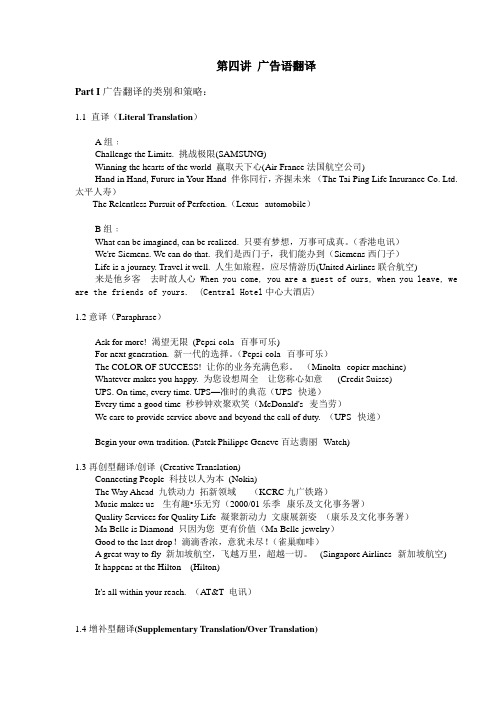
第四讲广告语翻译Part I广告翻译的类别和策略:1.1 直译(Literal Translation)A组﹕Challenge the Limits. 挑战极限(SAMSUNG)Winning the hearts of the world 赢取天下心(Air France法国航空公司)Hand in Hand, Future in Your Hand 伴你同行,齐握未来(The Tai Ping Life Insurance Co. Ltd. 太平人寿)The Relentless Pursuit of Perfection.(Lexus--automobile)B组﹕What can be imagined, can be realized. 只要有梦想,万事可成真。
(香港电讯)We're Siemens. We can do that. 我们是西门子,我们能办到(Siemens西门子)Life is a journey. Travel it well. 人生如旅程,应尽情游历(United Airlines联合航空)来是他乡客去时故人心 When you come, you are a guest of ours, when you leave, we are the friends of yours. (Central Hotel中心大酒店)1.2意译(Paraphrase)Ask for more! 渴望无限(Pepsi-cola--百事可乐)For next generation. 新一代的选择。
(Pepsi-cola--百事可乐)The COLOR OF SUCCESS! 让你的业务充满色彩。
(Minolta--copier machine)Whatever makes you happy. 为您设想周全让您称心如意(Credit Suisse)UPS. On time, every time. UPS—准时的典范(UPS--快递)Every time a good time 秒秒钟欢聚欢笑(McDonald's--麦当劳)We care to provide service above and beyond the call of duty. (UPS--快递)Begin your own tradition. (Patek Philippe Geneve百达翡丽--Watch)1.3再创型翻译/创译(Creative Translation)Connecting People 科技以人为本(Nokia)The Way Ahead 九铁动力拓新领域(KCRC九广铁路)Music makes us 生有趣•乐无穷(2000/01乐季--康乐及文化事务署)Quality Services for Quality Life 凝聚新动力文康展新姿(康乐及文化事务署)Ma Belle is Diamond 只因为您更有价值(Ma Belle-jewelry)Good to the last drop!滴滴香浓,意犹未尽!(雀巢咖啡)A great way to fly 新加坡航空,飞越万里,超越一切。
Lecture 8翻译技巧(词义的延伸)
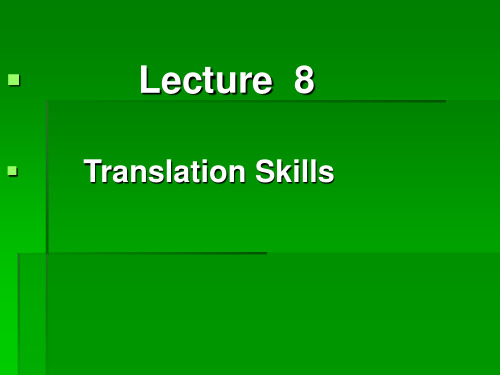
英语中,特别在现代英语中,常常用一个表示具体形象 的词来表示一种属性、一个事物或一种概念。翻译这类 词时,一般可将其词义作抽象化的引伸,译文才能流畅、 自然。 将表示具体形象的词译成该形象所代表的属性的词 There is a mixture of the tiger and the ape in the character of the imperialists. 帝国主义者的性格既残暴,又狡猾。 这里把tiger(老虎)和ape(猿)这两个具体形象引伸 为这两个形象所代表的属性:“残暴”和“狡猾”。 Every life has its roses and thorns. 每个人的生活都有甜和苦。 这里把roses(玫瑰)和thorns(刺)这两个具体形象 引伸为这两个形象所代表的属性:“甜”和“苦”。
On Studies 王佐良译《论读书》 水天同《论学问》 Studies serve for delight, for ornament, and for ability. 水译:读书为学的用途是娱乐、装饰和增长才识。 王译:读书足以怡情,足以傅彩,足以长才。 Their chief use for delight, is in privateness and retiring; for ornament, is in discourse; and for ability, is in the judgment, and disposition of business. 水译:在娱乐上学问的主要的用处是幽居养静;在装饰 上学问的用处是辞令;在长才上学问的用处是对于事务 的判断和处理。 王译:其怡情也,最见于独处幽居之时;其傅彩也,最 见于高谈阔论之中;其长才也,最见于处世判事之际。
Lecture 3 翻译的标准

Lecture 3 翻译的标准翻译标准:目前翻译界普遍接受的,也是作为一般翻译学习者必须努力掌握的标准,简而言之是两条:忠实(Faithfulness) 和流畅(Smoothness)。
外语腔是初学翻译者不知不觉地会在汉语译文中表现出来的一种不当倾向。
翻译时所要表达的内容来自外语原文,原文的词语和结构形式随着内容一起进入到我们的大脑,于是原文的语言形式被带入译文,造成了译文的外语腔。
The only concession he made to the climate was to wear a white dinner jacket.【译文】气候变化,他仅稍稍作了一点变通,赴宴时穿了件白色的短礼服。
翻译标准:忠实和流畅好的译文还必须保持原文的风格包括民族风格、时代风格、语体风格、作者个人的语言风格等。
即:译者不能破坏或改变原文的风格,不能以译者的风格代替原作的风格。
课堂练习:•She couldn't have come at a better time.•She has been a widow only six months.•I believe the speech was needlessly stubborn.•The Englishman feels no less deeply than any other nationality.•From a physical standpoint, there ought to be as many colours as there are different wave lengths.•As a human being, we should demonstrate our intellectual and moral superiority by respecting others for who they are -- instead of rejecting them for who/what they are not.1. 她来得正是时候。
concentrator翻译中文

concentrator翻译中文Concentrator的中文翻译是“浓缩器”或“集中器”。
这是一个广泛应用于不同领域的设备,用于将物质或能量从一个系统中集中起来。
在化学工程中,浓缩器通常用于将溶液中的溶剂蒸发掉,从而使溶液变得更加浓缩。
例如,蒸馏塔是一种常见的浓缩器,可用于从溶液中分离出纯的液体化合物。
在能源领域,太阳能集中器是一种利用镜面或透镜聚焦太阳能的设备。
这种集中器可以将太阳能转化为热能或光能,并用于发电或供热。
在通信领域,集中器是一种设备,用于将多个通信信号或数据流集中到一个中心点,从而实现集中管理和分发。
例如,网络交换机是一种常见的集中器,用于将多个计算机或设备连接到一个网络中。
以下是一些用法和中英文对照例句:1. The concentrator is used to evaporate the solvent from the solution, leaving behind a concentrated substance. (浓缩器用于将溶剂从溶液中蒸发掉,留下浓缩的物质。
)2. The solar concentrator focuses sunlight onto a small area, generating intense heat for power generation. (太阳能集中器将阳光聚焦在一个小区域,产生高温用于发电。
)3. The data concentrator gathers multiple data streams from different sources and sends them to a central server for processing. (数据集中器从不同来源汇集多个数据流,并将其发送到中央服务器进行处理。
)4. The concentrator is a crucial component in the distillation process, allowing for the separation of different compounds based on their boiling points. (浓缩器是蒸馏过程中的关键组件,能够根据不同化合物的沸点进行分离。
中医药名词英文翻译07(方剂学)
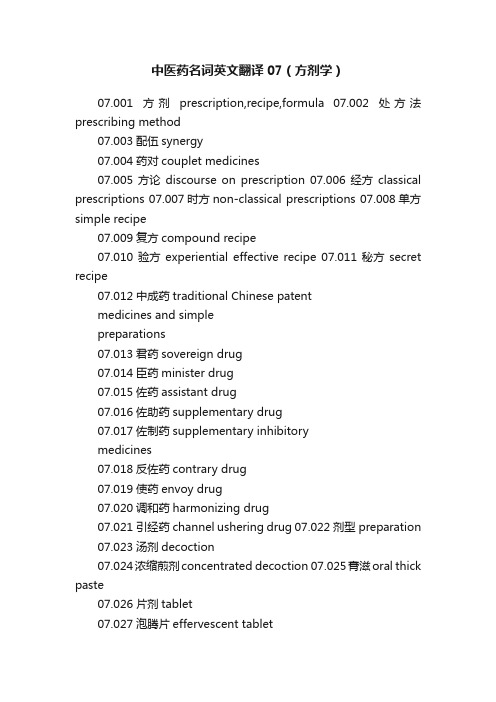
中医药名词英文翻译07(方剂学)07.001方剂prescription,recipe,formula 07.002处方法prescribing method07.003配伍synergy07.004药对couplet medicines07.005方论discourse on prescription 07.006经方classical prescriptions 07.007时方non-classical prescriptions 07.008单方simple recipe07.009复方compound recipe07.010验方experiential effective recipe 07.011秘方secret recipe07.012中成药traditional Chinese patentmedicines and simplepreparations07.013君药sovereign drug07.014臣药minister drug07.015佐药assistant drug07.016佐助药supplementary drug07.017佐制药supplementary inhibitorymedicines07.018反佐药contrary drug07.019使药envoy drug07.020调和药harmonizing drug07.021引经药channel ushering drug 07.022剂型preparation07.023汤剂decoction07.024浓缩煎剂concentrated decoction 07.025膏滋oral thick paste07.026片剂tablet07.027泡腾片effervescent tablet07.028线剂thread formula07.029条剂stripe formula07.030露剂distillate formula07.031膏药plaster;medicinal paste 07.032软膏剂ointment07.033散剂powder07.034丸剂pill, bolus07.035蜜丸honeyed pill07.036水丸watered pill07.037水蜜丸water-honeyed pill 07.038糊丸flour and water paste pill 07.039浓缩丸concentrated pill07.040蜡丸wax pill07.041微丸mini-pill07.042滴丸剂dripping pill07.043颗粒剂granules07.044胶囊剂capsule07.045硬胶囊剂hard capsule07.046软胶囊剂soft capsule07.047微囊剂micro-capsule07.048茶剂medicinal tea07.049糕剂cake07.050栓剂suppository07.051搽剂liniment07.052锭剂lozenge07.053[烟]熏剂smoke fumigant 07.054曲剂fermented medicine 07.055胶剂gel07.056气雾剂aerosol07.057喷雾剂spray07.058灌肠剂enema07.059灸剂moxibustion formula 07.060熨剂compression formula 07.061合剂mixture07.062酊剂tincture07.063酒剂wine07.064浸膏剂extract07.065流浸膏剂liquid extract07.066口服液oral liquid07.067糖浆剂syrup07.068注射剂injection07.069乳剂emulsion07.070滴鼻剂nasal drop07.071滴眼剂eye drop07.072滴耳剂ear drop07.073水煎decoct with water 07.074酒煎decoct with wine 07.075先煎decocted earlier 07.076后下decocted later07.077包煎wrap-boiling07.078另煎decocted separately07.079烊化melt07.080兑入mix07.081生汁兑入mix with fresh juice07.082溶化dissolve07.083冲服administered after dissolved 07.084火候optimal fire07.085文火mild fire07.086武火strong fire07.087临睡服administered before bed time 07.088饭前服administered before meal; a.c.;ante cibum07.089饭后服administered after meal ; p.c.;post cibum07.090空腹服administered at empty stomach 07.091热服administered hot07.092温服administered warm07.093冷服administered cold07.094噙化administered under tongue 07.095顿服administered at draught07.096分服taken separately07.097频服taken frequently07.098药引medicinal usher07.099解表剂superficies-resolving formula 07.100辛温解表剂formula for relieving superficiessyndrome with pungent andwarm natured drugs07.101辛凉解表剂formula for relieving superficiessyndrome with pungent and coolnatrued drugs07.102扶正解表剂formula for strengthening bodyresistance and relievingsuperficies07.103表里双解剂formula for relieving bothsuperficial and internal disorders 07.104解表清里剂formula for relieving superficiesand clearing interior07.105解表温里剂formula for relieving superficiesand warming interior07.106解表通里剂formula for relieving superficiesand catharsis07.107和解少阳剂reconciling shaoyang formula 07.108清热剂heat-clearing formula07.109清气分热剂formula for clearing heat at qilevel07.110清营凉血剂formula for clearing nutrient leveland cooling blood07.111清热解毒剂formula for clearing heat andremoving toxicity07.112清脏腑热剂formula for clearing heat inviscerae07.113清热解暑剂formula for clearing heat andanti-summer- heat07.114清虚热剂formula for clearing asthenicfever07.115温里剂warming interior formula07.116温中散寒剂formula for warming interior fordispersing cold07.117回阳救逆剂formula for restoring yang andrescuing patient from collapse 07.118温经散寒剂formula for warming channel fordispersing cold07.119泻下剂formula for purgation07.120寒下剂cold cathartic formula07.121温下剂warm cathartic formula07.122润下剂moistened cathartic formula 07.123逐水剂drastic diuretics formula07.124补益剂supplementing [and boosting]formula07.125补气剂qi-supplementing formula07.126补血剂blood-supplementing formula07.127气血双补剂formula for benefiting both qi andblood07.128补阴剂yin-supplementing formula07.129补阳剂yang-supplementing formula 07.130阴阳并补剂formula for benefiting both yinand yang07.131固涩剂astringent formula07.132固表止汗剂formula for consolidatingsuperficies for arresting sweating 07.133敛肺止咳剂formula for astringing lung forrelieving cough07.134涩肠固脱剂formula for astringing intestineand arresting proptosis07.135涩精止遗剂formula for astringingspermatorrhea07.136固崩止带剂formula for arresting leucorrheaand metrorrhagia07.137安神剂sedative;tranquillizing formula 07.138消食剂digestive formula07.139开窍剂formula for resuscitation07.140凉开剂cold formula for resuscitation 07.141温开剂warm formula for resuscitation 07.142理气剂carminative formula;qi regulatedformula07.143行气剂formula for activating qi flowing 07.144降气剂formula for descending qi07.145理血剂blood-regulating formula07.146活血剂blood-activating formula07.147止血剂blood-stanching formula07.148治风剂formula for wind disorder07.149疏散外风剂formula for dispersing externalwind07.150平熄内风剂formula for calming downinternal wind07.151祛湿剂desiccating formula07.152和胃燥湿剂formula for harmonizing thestomach and drying dampness 07.153清热祛湿剂formula for clearing heat andeliminating dampness07.154利水渗湿剂formula for diuresis and diffusingdampness07.155温化水湿剂formula for warmly resolvingwatery dampness07.156祛痰剂phlegm-expelling formula07.157温燥化痰剂formula for resolving phlegmwith warm drugs07.158清润化痰剂formula for resolving phlegmwith clear-moistening drugs 07.159治风化痰剂formula for resolving phlegmwith arresting wind07.160驱虫剂anti-helminthic formula07.161涌吐剂emetic formula07.162一贯煎yiguan decoction07.163丁香柿蒂汤dingxiang shidi decoction07.164七宝美髯丹qibao meiran mini-pills07.165七厘散qili powder;qili san07.166九仙散jiuxian powder07.167九味羌活汤jiuwei qianghuo decoction07.168二至丸erzhi pills07.169二妙散ermiao powder07.170二陈汤erchen decoction07.171八正散bazheng powder07.172八珍汤bazhen decoction07.173十灰散shihui powder07.174十枣汤shizao decoction07.175三子养亲汤sanzi yangqin decoction 07.176三甲复脉汤sanjia fumai decoction 07.177三仁汤sanren decoction07.178三物备急丸sanwu beiji pill07.179川芎茶调散chuanxiong chatiao powder;chuanxiong chatiao san07.180大补阴丸da buyin pill;da buyin wan 07.181大定风珠dadingfengzhu pill07.182大建中汤dajianzhong decoction07.183大承气汤dachengqi decoction07.184大柴胡汤dachaihu decoction07.185大秦艽汤daqinjiao decoction07.186大黄牡丹汤dahuang mudan decoction 07.187大黄附子汤dahuang fuzi decoction 07.188小建中汤xiaojianzhong decoction 07.189小金丹xiaojin mini-pills07.190小青龙汤xiaoqinglong decoction 07.191小活络丹xiaohuoluo mini-pills 07.192小柴胡汤xiaochaihu decoction 07.193小续命汤xiaoxuming decoction 07.194小蓟饮子xiaoji drink07.195小儿回春丹xiao'er huichun mini-pills 07.196乌梅丸wumei pills07.197五仁丸wuren pills07.198五皮饮wupi drink07.199五味消毒饮wuwei xiaodu drink07.200五苓散wuling powder;wuling san 07.201五积散wuji powder07.202六一散liuyi powder; liuyi san07.203六味地黄丸liuwei dihuang pill;liuweidihuang wan07.204内补黄芪汤neibu huangqi decoction07.205化虫丸huachong pill07.206升麻葛根汤shengma gegen decoction 07.207天王补心丹tianwang buxin mini-pills07.208天台乌药散tiantai wuyao powder07.209天麻钩藤饮tianma gouteng drink07.210木香槟榔丸muxiang binlang pills;muxiangbinlang wan07.211止痉散zhijing powder07.212止嗽散zhisou powder07.213贝母瓜蒌散beimu gualou powder07.214苇茎汤weijing decoction07.215仙方活命饮xianfang huoming drink07.216加减葳蕤汤jiajian weirui decoctionbanxia baizhu tianma decoction 07.217半夏白术天麻汤07.218半夏泻心汤banxia xiexin decoction07.219半夏厚朴汤banxia houpu decoction07.220右归丸yougui pill07.221右归饮yougui drink07.222四君子汤sijunzi decoction07.223四妙勇安汤simiao yong'an decoction 07.224四物汤siwu decoction07.225四神丸sishen pill;sishen wan 07.226四逆汤sini decoction;sini tang 07.227四逆散sini powder07.228失笑散shixiao powder07.229左归丸zuogui pill07.230左归饮zuogui drink07.231左金丸zuojin pill;zuojin wan07.232布袋丸budai pill07.233平胃散pingwei powder07.234归脾汤guipi decoction07.235玉女煎yunü decoction07.236玉屏风散yupingfeng powder07.237玉真散yuzhen powder;yuzhen san 07.238瓜蒂散guadi powder07.239甘麦大枣汤ganmai dazao decoction 07.240甘露消毒丹ganlu xiaodu micropills07.241生化汤shenghua decoction07.242生脉散shengmai powder; shengmaisan07.243白头翁汤baitouweng decoction07.244白虎汤baihu decoction07.245石斛夜光丸shihu yeguang pills;shihuyeguang wan07.246龙胆泻肝汤longdan xiegan decoction 07.247再造散zaizao powder;zaizao san 07.248地黄饮子dihuang drink07.249安宫牛黄丸angong niuhuang pills;angongniuhuang wan07.250导赤散daochi powder07.251当归六黄汤danggui liuhuang decoction 07.252当归四逆汤danggui sini decoction 07.253当归补血汤danggui buxue decoction 07.254朱砂安神丸zhusha anshen pills07.255百合固金汤baihe gujin decoction 07.256竹叶石膏汤zhuye shigao decoction 07.257至宝丹zhibao mini-pills07.258舟车丸zhouche pills07.259芍药汤shaoyao decoction07.260血府逐瘀汤xuefu zhuyu decoction 07.261防己黄芪汤fangji huangqi decoction07.262防风通圣散fangfeng tongsheng powder 07.263阳和汤yanghe decoction07.264吴茱萸汤wuzhuyu decoction07.265完带汤wandai decoction07.266杏苏散xingsu powder07.267牡蛎散muli powder07.268羌活胜湿汤qianghuo shengshi decoction 07.269苍耳散cang'er powder07.270苏子降气汤suzi jiangqi decoction07.271苏合香丸suhexiang pills;suhexiang wan07.272补中益气汤buzhongyiqi decoction07.273补阳还五汤buyang huanwu decoction 07.274补肺阿胶汤bufei ejiao decoction07.275连朴饮lianpu drink07.276麦门冬汤maimendong decoction07.277龟鹿二仙胶guilu erxian glue07.278参苏饮shensu drink07.279参附汤shenfu decoction。
翻译讲座心得(汇编6篇)
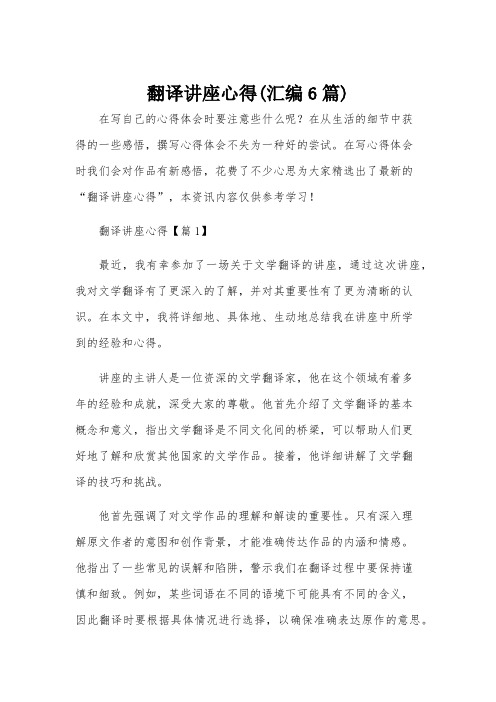
翻译讲座心得(汇编6篇)在写自己的心得体会时要注意些什么呢?在从生活的细节中获得的一些感悟,撰写心得体会不失为一种好的尝试。
在写心得体会时我们会对作品有新感悟,花费了不少心思为大家精选出了最新的“翻译讲座心得”,本资讯内容仅供参考学习!翻译讲座心得【篇1】最近,我有幸参加了一场关于文学翻译的讲座,通过这次讲座,我对文学翻译有了更深入的了解,并对其重要性有了更为清晰的认识。
在本文中,我将详细地、具体地、生动地总结我在讲座中所学到的经验和心得。
讲座的主讲人是一位资深的文学翻译家,他在这个领域有着多年的经验和成就,深受大家的尊敬。
他首先介绍了文学翻译的基本概念和意义,指出文学翻译是不同文化间的桥梁,可以帮助人们更好地了解和欣赏其他国家的文学作品。
接着,他详细讲解了文学翻译的技巧和挑战。
他首先强调了对文学作品的理解和解读的重要性。
只有深入理解原文作者的意图和创作背景,才能准确传达作品的内涵和情感。
他指出了一些常见的误解和陷阱,警示我们在翻译过程中要保持谨慎和细致。
例如,某些词语在不同的语境下可能具有不同的含义,因此翻译时要根据具体情况进行选择,以确保准确表达原作的意思。
然后,他分享了一些实际翻译中常用的技巧。
他提到了找到合适的语言风格和声音的重要性。
不同的文学作品有着不同的风格和调调,翻译者需要根据作品的特点和目标读者的背景,灵活运用不同的翻译策略,以尽可能地还原原作的风格。
他还强调了语言的简洁和准确的重要性,指出翻译不应该过于冗长和啰嗦,而应该力求简明扼要,使作品更富有力量和魅力。
在讲座中,他还谈到了文化差异对翻译的影响。
不同的文化有着不同的价值观和习惯,这些因素对于译者来说是一个巨大的挑战。
翻译者需要在尊重原文的基础上,根据目标文化的特点和读者的需求进行必要的调整和处理。
他举了一些具体的例子,让我们更加直观地感受到文化差异对于翻译的重要性和难度。
他提出了一些建议,帮助我们成为更好的翻译者。
他强调了阅读的重要性。
【英文演讲】英语笔译复习笔记
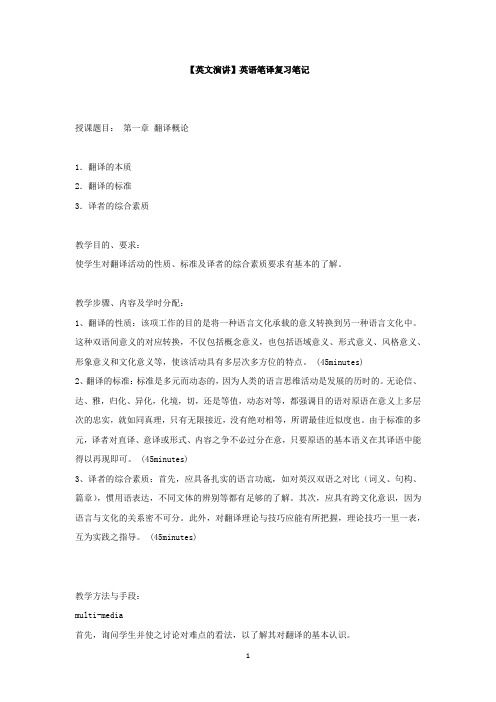
【英文演讲】英语笔译复习笔记授课题目:第一章翻译概论1.翻译的本质2.翻译的标准3.译者的综合素质教学目的、要求:使学生对翻译活动的性质、标准及译者的综合素质要求有基本的了解。
教学步骤、内容及学时分配:1、翻译的性质:该项工作的目的是将一种语言文化承载的意义转换到另一种语言文化中。
这种双语间意义的对应转换,不仅包括概念意义,也包括语域意义、形式意义、风格意义、形象意义和文化意义等,使该活动具有多层次多方位的特点。
(45minutes)2、翻译的标准:标准是多元而动态的,因为人类的语言思维活动是发展的历时的。
无论信、达、雅,归化、异化,化境,切,还是等值,动态对等,都强调目的语对原语在意义上多层次的忠实,就如同真理,只有无限接近,没有绝对相等,所谓最佳近似度也。
由于标准的多元,译者对直译、意译或形式、内容之争不必过分在意,只要原语的基本语义在其译语中能得以再现即可。
(45minutes)3、译者的综合素质:首先,应具备扎实的语言功底,如对英汉双语之对比(词义、句构、篇章),惯用语表达,不同文体的辨别等都有足够的了解。
其次,应具有跨文化意识,因为语言与文化的关系密不可分。
此外,对翻译理论与技巧应能有所把握,理论技巧一里一表,互为实践之指导。
(45minutes)教学方法与手段:multi-media首先,询问学生并使之讨论对难点的看法,以了解其对翻译的基本认识。
其次,结合教材与参考书,尽量使学生明白翻译理论与实践的辨证关系,以及翻译活动与翻译史、语言学、文学和文化的联系。
思考题:与以前相比,学生对翻译的看法有何不同?参考资料:1、高级英汉翻译-理论与实践叶子南2.当代翻译理论刘宓庆3. 新编汉英翻译教程陈宏薇4. 理解与表达韩其顺授课题目:第二章句子结构翻译1.句子的拆分2、句子的合句3、句子结构的改变教学目的、要求:使学生对句子结构(英汉)翻译有基本的了解,如句法对比、概念、类型和意合、形合。
Lecture 6 句法翻译1
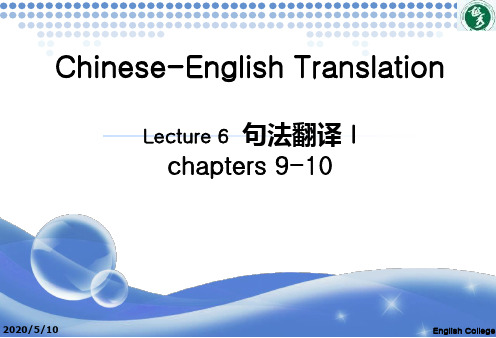
2011-5-4
4
English College
Try to translate the following sentences: 今天食堂吃饺子。
叉子吃不好吃筷子吧。
吃食堂味道不好。
2011-5-4 5 English College
到底 “谁” 吃“谁”?! 这种紊乱的施事(Agent Agent)与受事(Object Object)关系在 Agent Object 英语中简直是离经叛道,却在汉语里显得那么自然。 (今天食堂有 Jiaozi are served in the canteen today. ( 饺子吃) ) Eat with chopsticks if you can’t (do it well) with a fork. ( (用叉子吃不好就用筷子吃吧) ) The food served in the canteen doesn’t taste (在食堂吃的饭菜味道不好) good. ( ) 英语上述各句中的“吃”都隐含有逻辑主语(即施事 者)“人”,而原文句中的主语功能都变成了施事的 方式或场所。 2011-5-4 6 English College
2011-5-4 14 English College
2).问遍千家成行家。 Learn from numerous advisers , and you will become a master.
2011-5-4
15
English College
2.汉语的散点思维 2. 他有个女儿,在北京工作,已经打电话去了,听说明天就能回来。 , , , Version A :His daughter works in Beijing has been called, His and she would come back tomorrow. B:He Version B He has a daughter, working in Peking, who we have given a call and we hear of that she will come back tomorrow. 汉语句子变换了主语,并将其省略。补出主语后句子是这样的: 他有个女儿,(她)在北京工作,(有人)已经打电话去了,( 人们)听说(她)明天就能回来。 可以看出两例的译文基本没有摆脱原文形式的束缚,主语选择不 符合英语表达习惯。 It is heard of that his daughter who works in Beijing will come back tomorrow. 2011-5-4 16 English College
翻译的讲座心得体会(实用16篇)
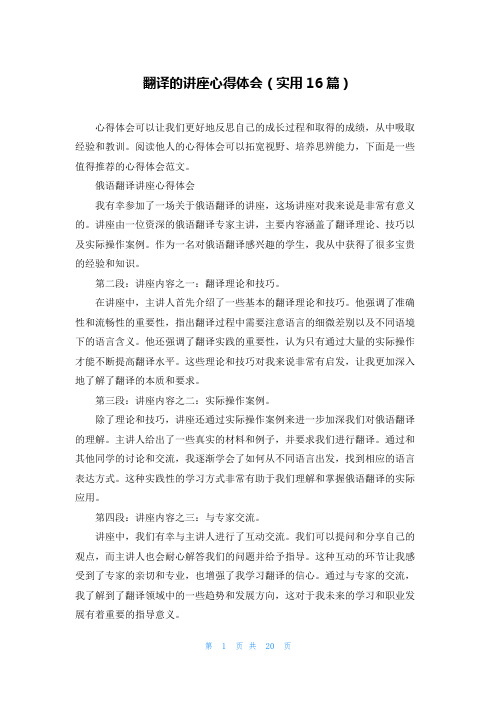
翻译的讲座心得体会(实用16篇)心得体会可以让我们更好地反思自己的成长过程和取得的成绩,从中吸取经验和教训。
阅读他人的心得体会可以拓宽视野、培养思辨能力,下面是一些值得推荐的心得体会范文。
俄语翻译讲座心得体会我有幸参加了一场关于俄语翻译的讲座,这场讲座对我来说是非常有意义的。
讲座由一位资深的俄语翻译专家主讲,主要内容涵盖了翻译理论、技巧以及实际操作案例。
作为一名对俄语翻译感兴趣的学生,我从中获得了很多宝贵的经验和知识。
第二段:讲座内容之一:翻译理论和技巧。
在讲座中,主讲人首先介绍了一些基本的翻译理论和技巧。
他强调了准确性和流畅性的重要性,指出翻译过程中需要注意语言的细微差别以及不同语境下的语言含义。
他还强调了翻译实践的重要性,认为只有通过大量的实际操作才能不断提高翻译水平。
这些理论和技巧对我来说非常有启发,让我更加深入地了解了翻译的本质和要求。
第三段:讲座内容之二:实际操作案例。
除了理论和技巧,讲座还通过实际操作案例来进一步加深我们对俄语翻译的理解。
主讲人给出了一些真实的材料和例子,并要求我们进行翻译。
通过和其他同学的讨论和交流,我逐渐学会了如何从不同语言出发,找到相应的语言表达方式。
这种实践性的学习方式非常有助于我们理解和掌握俄语翻译的实际应用。
第四段:讲座内容之三:与专家交流。
讲座中,我们有幸与主讲人进行了互动交流。
我们可以提问和分享自己的观点,而主讲人也会耐心解答我们的问题并给予指导。
这种互动的环节让我感受到了专家的亲切和专业,也增强了我学习翻译的信心。
通过与专家的交流,我了解到了翻译领域中的一些趋势和发展方向,这对于我未来的学习和职业发展有着重要的指导意义。
第五段:总结和展望。
通过参加这场关于俄语翻译的讲座,我对翻译有了更深刻的认识并学到了许多有价值的知识。
我将努力运用这些理论和技巧,不断提高自己的翻译水平。
同时,我也会继续关注翻译领域的最新动态,了解并适应其发展趋势。
我相信,通过持续的学习和实践,我能够成为一名优秀的俄语翻译员,并为促进中俄两国之间的交流和合作做出自己的贡献。
英语八级汉英翻译讲座(含名篇15篇)

练习1徐霞客*徐霞客一生周游考察了十六个省,足迹几乎遍及全国。
他在考察的过程中,从来不盲目迷信书本上的结论。
他发现前人研究的地理的记载有许多不很可靠的地方。
为了进行真实细致的考察,他很少乘车坐船,几乎全靠双脚翻山越岭,长途跋涉;为了弄清大自然的真相,他总是挑选道路艰险的山区,人迹稀少的森林进行考察,发现了许多奇山秀景;他常常选择不同的时间和季节,多次重游各地名山,反复观察变换的奇景。
徐霞客一生周游考察了十六个省,足迹几乎遍及全国。
*周游:到各处游历; 走遍travel across (around);tour;visit*考察: explore; make an on-the-spot investigation; inspect*足迹:footprint;footmark; trace*遍及spread all over*During his life time, Xu Xiake visited and explored 16 provinces, leaving his footprints in nearly every corner of the country.他在考察的过程中,从来不盲目迷信书本上的结论。
*他在考察的过程中: in his exploration; in his tours;on his tours*盲目:blindly; in a blind way; without thinking*迷信: superstition; blindly worship/ believe in。
*这里“迷信”指接受accept readily/without thinking*He never blindly accepted the conclusions given in books in his exploration.他发现前人研究的地理的记载有许多不很可靠的地方。
*前人:predecessor; forefathers; others*前人栽树,后人乘凉。
汉英翻译讲座(17)
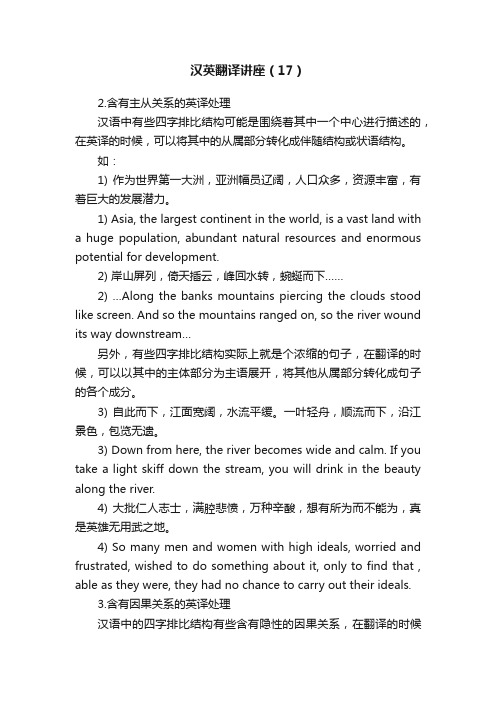
汉英翻译讲座(17)2.含有主从关系的英译处理汉语中有些四字排比结构可能是围绕着其中一个中心进行描述的,在英译的时候,可以将其中的从属部分转化成伴随结构或状语结构。
如:1) 作为世界第一大洲,亚洲幅员辽阔,人口众多,资源丰富,有着巨大的发展潜力。
1) Asia, the largest continent in the world, is a vast land witha huge population, abundant natural resources and enormous potential for development.2) 岸山屏列,倚天插云,峰回水转,蜿蜒而下……2) …Along the banks mountains piercing the clouds stood like screen. And so the mountains ranged on, so the river wound its way downstr eam…另外,有些四字排比结构实际上就是个浓缩的句子,在翻译的时候,可以以其中的主体部分为主语展开,将其他从属部分转化成句子的各个成分。
3) 自此而下,江面宽阔,水流平缓。
一叶轻舟,顺流而下,沿江景色,包览无遗。
3) Down from here, the river becomes wide and calm. If you take a light skiff down the stream, you will drink in the beauty along the river.4) 大批仁人志士,满腔悲愤,万种辛酸,想有所为而不能为,真是英雄无用武之地。
4) So many men and women with high ideals, worried and frustrated, wished to do something about it, only to find that , able as they were, they had no chance to carry out their ideals.3.含有因果关系的英译处理汉语中的四字排比结构有些含有隐性的因果关系,在翻译的时候通常是将表示原因的部分放在前面,将结果部分放在后面,中间用“导致”或“形成”这样的动词连接。
文学翻译十讲 笔记
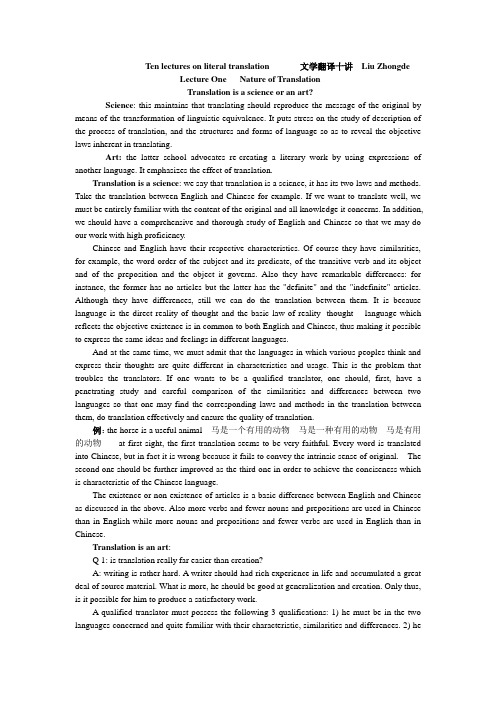
T en lectures on literal translation 文学翻译十讲Liu ZhongdeLecture One Nature of T ranslationT ranslation is a science or an art?Science: this maintains that translating should reproduce the message of the original by means of the transformation of linguistic equivalence. It puts stress on the study of description of the process of translation, and the structures and forms of language so as to reveal the objective laws inherent in translating.Art:the latter school advocates re-creating a literary work by using expressions of another language. It emphasizes the effect of translation.Translation is a science: we say that translation is a science, it has its two laws and methods. Take the translation between English and Chinese for example. If we want to translate well, we must be entirely familiar with the content of the original and all knowledge it concerns. In addition, we should have a comprehensive and thorough study of English and Chinese so that we may do our work with high proficiency.Chinese and English have their respective characteristics. Of course they have similarities, for example, the word order of the subject and its predicate, of the transitive verb and its object and of the preposition and the object it governs. Also they have remarkable differences: for instance, the former has no articles but the latter has the "definite" and the "indefinite" articles. Although they have differences, still we can do the translation between them. It is because language is the direct reality of thought and the basic law of reality--thought----language which reflects the objective existence is in common to both English and Chinese, thus making it possible to express the same ideas and feelings in different languages.And at the same time, we must admit that the languages in which various peoples think and express their thoughts are quite different in characteristics and usage. This is the problem that troubles the translators. If one wants to be a qualified translator, one should, first, have a penetrating study and careful comparison of the similarities and differences between two languages so that one may find the corresponding laws and methods in the translation between them, do translation effectively and ensure the quality of translation.例:the horse is a useful animal 马是一个有用的动物马是一种有用的动物马是有用的动物at first sight, the first translation seems to be very faithful. Every word is translated into Chinese, but in fact it is wrong because it fails to convey the intrinsic sense of original. The second one should be further improved as the third one in order to achieve the conciseness which is characteristic of the Chinese language.The existence or non-existence of articles is a basic difference between English and Chinese as discussed in the above. Also more verbs and fewer nouns and prepositions are used in Chinese than in English while more nouns and prepositions and fewer verbs are used in English than in Chinese.Translation is an art:Q 1: is translation really far easier than creation?A: writing is rather hard. A writer should had rich experience in life and accumulated a great deal of source material. What is more, he should be good at generalization and creation. Only thus, is it possible for him to produce a satisfactory work.A qualified translator must possess the following 3 qualifications: 1) he must be in the two languages concerned and quite familiar with their characteristic, similarities and differences. 2) hemust have a thorough understanding of the content, artistic features and style of the original and the historical background in which it was written. 3) he must know very well the basic principles and methods of translation and is experienced in practice.Y an Fu once said: it often takes as long as ten days or even a whole month to establish a term in translation after repeated consideration and hesitation.The difficulty in translation lies in the fact that the content and the style are already existent in the original and as a result, you will have to do your best to reproduce them as they are in quite a different language.So translation is not only a science with its own laws and methods but also an art of reproduction and re-creation.Lecture two Principles of translation信,达,切---faithfulness, expressiveness and closenessFaithfulness---to be faithful to the content of the originalExpressiveness---to be as expressive as the originalCloseness---to be as close to the original style as possibleOnly after a translator achieves the faithfulness in content and smoothness or expressiveness in wording can be further pursue the closeness in style.Lecture Three literal translation and free translation Literal translation: an adequate representation of the original almost without any change of word-order or sentence structure.Free translation: an alternative approach which is used mainly to convey the meaning and spirit of the original without trying to reproduce its sentence patterns of figures of speech.例证:kill two birds with one stone析:literal translation----一石二鸟Free translation-----一举两得Combination--------一箭双雕例证:你不要班门弄斧了析:literal translation-- don't display your axe at Lu Ban's door .........for Chinese readers Free translation----don't teach you grandmother to suck eggs.......For foreign readersFree translation----never offer to each a fish to swim.Lecture Five Commonly-used methods of translation1) corresponding sentence patters 句型对应例证:as soon as he come to Changsha, he paid a visit to Y uelu Academy译:他一到长沙,就访问了岳麓书院例证:你书读的越多,你就会越有学问译:the more you read, the more learned you will become2) rearrangement of word order 次序调整例证:when he was twelve, Mark Twain lost his father 译:马克吐温十二岁时失去了父亲3)conversion of part of speech 词类转化例证:he dialed the wrong number 译:他拨错了电话号码4)proper addition or omission例证:we don't retreat, we never have and never will译:我们不后退,我们不曾后悔,我们也永远不会后退例证:Bob got up very early in the morning 译:早上Bob起的很早。
Lecture 4.直译-意译与翻译腔
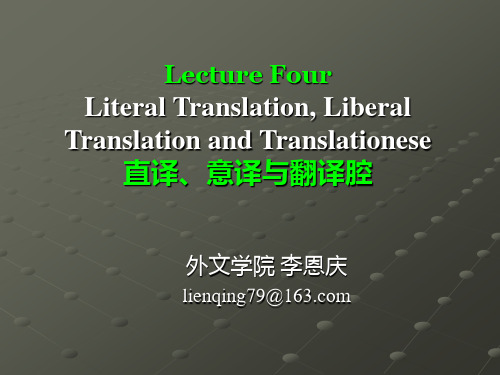
直译可行则尽量直译。 直译可行则尽量直译。
树倒猢狲散。 树倒猢狲散。
直译:When the tree falls,the monkeys scatter. falls, scatter. 直译: 意译: ship. 意译:Rats leave a sinking ship.
A man may usually be known by the books he reads as well as by the company he keeps, for there is a companionship of books as well as of men.
误:古老的小日本漂游在灰棕色的钢筋混凝土摩天大楼之间的 古老的小日本漂游在灰棕色的钢筋混凝土摩天大楼之间的 引入景象是和服与超短裙之间的不断斗争的象征。 引入景象是和服与超短裙之间的不断斗争的象征。 式样古老小巧的日本房屋像小船一般, 正:式样古老小巧的日本房屋像小船一般,漂游在灰棕色的钢 筋混凝土摩天大楼之间,这引人注目的景象象征着旧传统和新 筋混凝土摩天大楼之间,这引人注目的景象象征着旧传统和新 发展之间的不断斗争 之间的不断斗争。 发展之间的不断斗争。
Lecture Four
Literal Translation, Liberal Translation and Translationese 直译、 直译、意译与翻译腔
谭载喜教授讲座
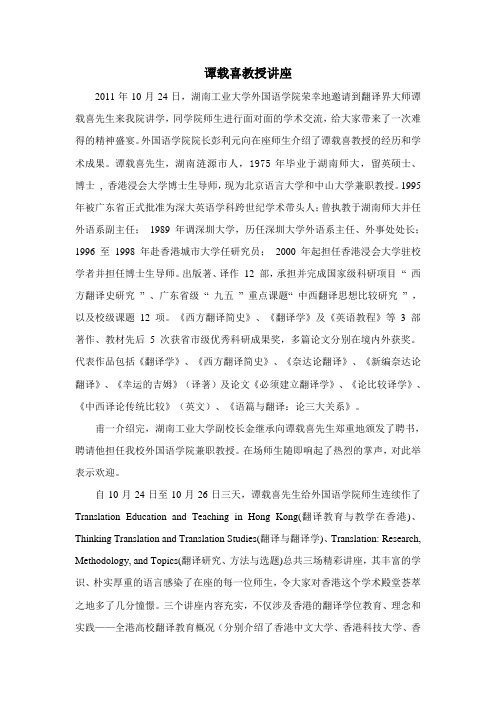
谭载喜教授讲座2011年10月24日,湖南工业大学外国语学院荣幸地邀请到翻译界大师谭载喜先生来我院讲学,同学院师生进行面对面的学术交流,给大家带来了一次难得的精神盛宴。
外国语学院院长彭利元向在座师生介绍了谭载喜教授的经历和学术成果。
谭载喜先生,湖南涟源市人,1975年毕业于湖南师大,留英硕士、博士, 香港浸会大学博士生导师,现为北京语言大学和中山大学兼职教授。
1995 年被广东省正式批准为深大英语学科跨世纪学术带头人;曾执教于湖南师大并任外语系副主任;1989 年调深圳大学,历任深圳大学外语系主任、外事处处长;1996 至1998 年赴香港城市大学任研究员;2000 年起担任香港浸会大学驻校学者并担任博士生导师。
出版著、译作12 部,承担并完成国家级科研项目“ 西方翻译史研究” 、广东省级“ 九五” 重点课题“ 中西翻译思想比较研究” ,以及校级课题12 项。
《西方翻译简史》、《翻译学》及《英语教程》等 3 部著作、教材先后 5 次获省市级优秀科研成果奖,多篇论文分别在境内外获奖。
代表作品包括《翻译学》、《西方翻译简史》、《奈达论翻译》、《新编奈达论翻译》、《幸运的吉姆》(译著)及论文《必须建立翻译学》、《论比较译学》、《中西译论传统比较》(英文)、《语篇与翻译:论三大关系》。
甫一介绍完,湖南工业大学副校长金继承向谭载喜先生郑重地颁发了聘书,聘请他担任我校外国语学院兼职教授。
在场师生随即响起了热烈的掌声,对此举表示欢迎。
自10月24日至10月26日三天,谭载喜先生给外国语学院师生连续作了Translation Education and Teaching in Hong Kong(翻译教育与教学在香港)、Thinking Translation and Translation Studies(翻译与翻译学)、Translation: Research, Methodology, and Topics(翻译研究、方法与选题)总共三场精彩讲座,其丰富的学识、朴实厚重的语言感染了在座的每一位师生,令大家对香港这个学术殿堂荟萃之地多了几分憧憬。
英汉语言对比与翻译 讲义(一)

英汉语言对比与翻译讲义(一)一、西方圣经翻译纵观西方翻译史,有几件大事尤其值得我们特别注意,第一是罗马人征服希腊以后,发现希腊灿烂的文明远远高出罗马,于是翻译之风大盛,代表人物有西塞罗(Cicero,106-43B.C.)、贺拉斯( Horatius,65-8B.C.)、昆体良(Quintilianus,35?-95?),这一时期的主要特点是活译,以原文为基础的创造性翻译,翻译和创作之间没有根本的界限。
我们今天发现罗马神话很多不过是希腊神话的翻版,原因盖出于此。
第二件大事:7、8世纪,阿拉伯人向外扩张,征服了希腊世界,雅典成了翻译中心。
大批叙利亚学者来到雅典,把希腊作品译成古叙别亚语,带回巴格达;巴格达的翻译活动也非常活跃,翻译成古叙别亚语的译品和一些希腊原作被译成阿拉伯语。
但在10、11世纪,阿拉伯学术研究开始走下坡路,阿拉伯语作品于是大量涌向西班牙,托莱多取代了巴格达,成为欧洲的“翻译院”,书写于阿拉伯语的大量希腊作品又被译成拉丁语。
还有就是贯穿西方翻译史的《圣经》的翻译。
《圣经》的《旧约》(Old Testament)成书于公元前,原是犹太教的经典,原文为希伯来语(Hebrew)。
《新约》(New Testament)成2世纪下半叶,原文为希腊语。
公元前3世纪,耶路撒冷的主教应埃及国王的请求,派人去亚历山大城承担《旧约》的翻译工作。
于是,在285~249 B.C.年间,有72名高贵的犹太学者云集亚历山大城,从事这项翻译工作。
据传,这72名学者来自12个不同的以色列部落,每个部落6名。
他们来到亚历山大图书馆,两人一组,分在36个地方进行翻译,译出36篇彼此极为相似的译文。
最后,72人结合在一起,对36篇译稿进行对比,在措辞上取得一致意见,这个译本被称之为《七十子文本》或《七十贤士译本》,或《七十子希腊文本》(Septuagint)。
这个文本成了“第二原本”,有时甚至取代希伯来语文本而成为第一原本。
中医双语专家讲课稿范文
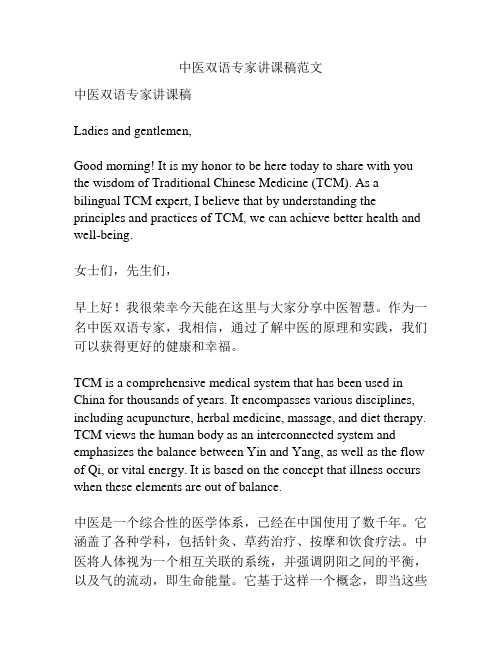
中医双语专家讲课稿范文中医双语专家讲课稿Ladies and gentlemen,Good morning! It is my honor to be here today to share with you the wisdom of Traditional Chinese Medicine (TCM). As a bilingual TCM expert, I believe that by understanding the principles and practices of TCM, we can achieve better health and well-being.女士们,先生们,早上好!我很荣幸今天能在这里与大家分享中医智慧。
作为一名中医双语专家,我相信,通过了解中医的原理和实践,我们可以获得更好的健康和幸福。
TCM is a comprehensive medical system that has been used in China for thousands of years. It encompasses various disciplines, including acupuncture, herbal medicine, massage, and diet therapy. TCM views the human body as an interconnected system and emphasizes the balance between Yin and Yang, as well as the flow of Qi, or vital energy. It is based on the concept that illness occurs when these elements are out of balance.中医是一个综合性的医学体系,已经在中国使用了数千年。
浓缩的英文单词
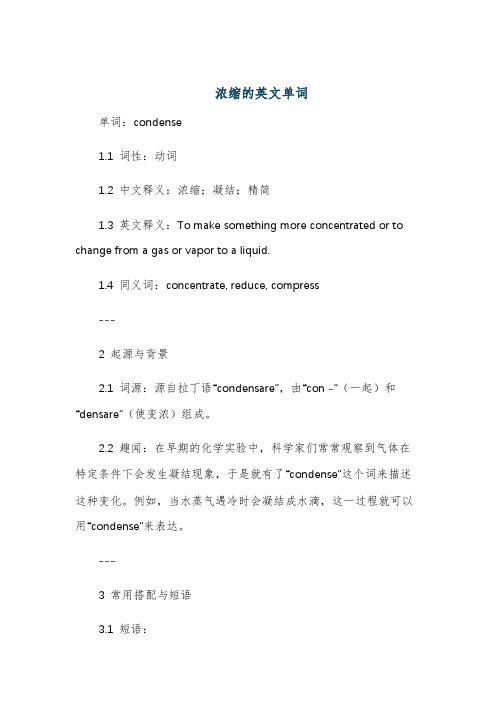
浓缩的英文单词单词:condense1.1 词性:动词1.2 中文释义:浓缩;凝结;精简1.3 英文释义:To make something more concentrated or to change from a gas or vapor to a liquid.1.4 同义词:concentrate, reduce, compress---2 起源与背景2.1 词源:源自拉丁语“condensare”,由“con -”(一起)和“densare”(使变浓)组成。
2.2 趣闻:在早期的化学实验中,科学家们常常观察到气体在特定条件下会发生凝结现象,于是就有了“condense”这个词来描述这种变化。
例如,当水蒸气遇冷时会凝结成水滴,这一过程就可以用“condense”来表达。
---3 常用搭配与短语3.1 短语:- condense into:浓缩成;凝结成例句:The vapor will condense into liquid droplets.翻译:蒸汽会凝结成小液滴。
- condense a story:精简故事例句:The editor asked the writer to condense the story to make it more suitable for the magazine.翻译:编辑要求作者精简故事以便更适合杂志刊登。
- condense one's thoughts:整理思绪例句:She took a few minutes to condense her thoughts before giving the speech.翻译:她在演讲前花了几分钟整理思绪。
---4 实用片段(1). “I need to condense this long report into a few pages. It's too wordy right now.” John said to his colleague. His colleague replied, “Yeah, that'll make it more focused and easier to read.”翻译:“我得把这份冗长的报告精简成几页。
浓缩的英文单词解释和例句
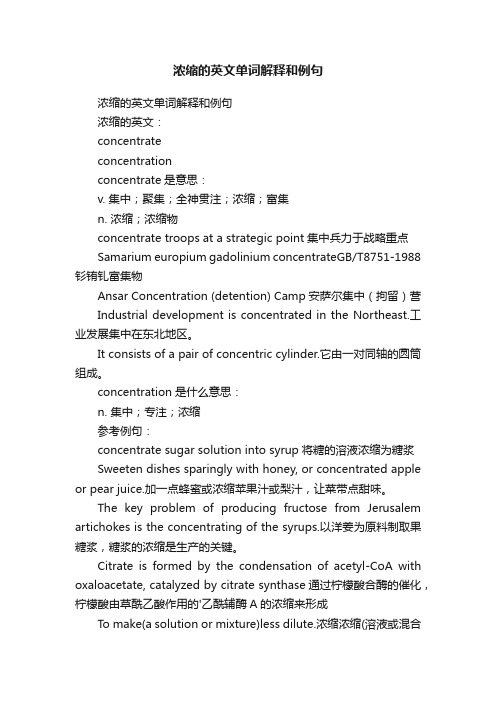
浓缩的英文单词解释和例句浓缩的英文单词解释和例句浓缩的英文:concentrateconcentrationconcentrate是意思:v. 集中;聚集;全神贯注;浓缩;富集n. 浓缩;浓缩物concentrate troops at a strategic point集中兵力于战略重点Samarium europium gadolinium concentrateGB/T8751-1988钐铕钆富集物Ansar Concentration (detention) Camp安萨尔集中(拘留)营Industrial development is concentrated in the Northeast.工业发展集中在东北地区。
It consists of a pair of concentric cylinder.它由一对同轴的圆筒组成。
concentration是什么意思:n. 集中;专注;浓缩参考例句:concentrate sugar solution into syrup将糖的溶液浓缩为糖浆Sweeten dishes sparingly with honey, or concentrated apple or pear juice.加一点蜂蜜或浓缩苹果汁或梨汁,让菜带点甜味。
The key problem of producing fructose from Jerusalem artichokes is the concentrating of the syrups.以洋姜为原料制取果糖浆,糖浆的浓缩是生产的关键。
Citrate is formed by the condensation of acetyl-CoA with oxaloacetate, catalyzed by citrate synthase通过柠檬酸合酶的催化,柠檬酸由草酰乙酸作用的'乙酰辅酶A的浓缩来形成To make(a solution or mixture)less dilute.浓缩浓缩(溶液或混合物)To undergo thickening or cause to thicken,as by boiling or evaporation;condense.浓缩通过沸腾或蒸发来浓缩或使浓缩;浓缩A little Body often harbors a great soul浓缩的都是精品All concentrated parts are essential.浓缩的都是精华。
凝聚英语动词
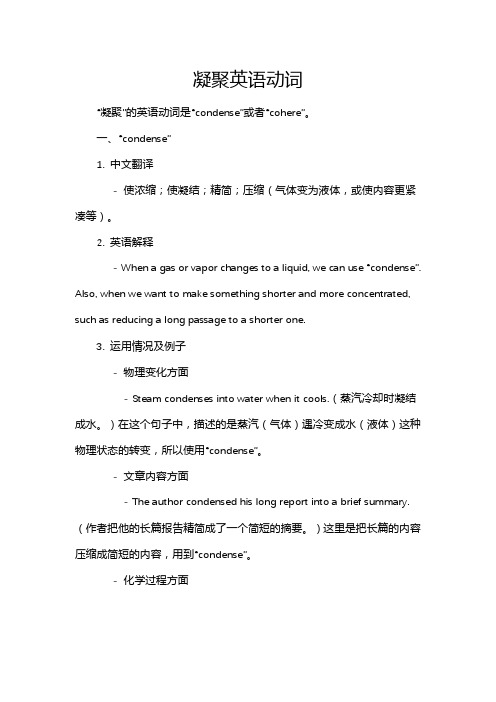
凝聚英语动词“凝聚”的英语动词是“condense”或者“cohere”。
一、“condense”1. 中文翻译- 使浓缩;使凝结;精简;压缩(气体变为液体,或使内容更紧凑等)。
2. 英语解释- When a gas or vapor changes to a liquid, we can use “condense”. Also, when we want to make something shorter and more concentrated, such as reducing a long passage to a shorter one.3. 运用情况及例子- 物理变化方面- Steam condenses into water when it cools.(蒸汽冷却时凝结成水。
)在这个句子中,描述的是蒸汽(气体)遇冷变成水(液体)这种物理状态的转变,所以使用“condense”。
- 文章内容方面- The author condensed his long report into a brief summary.(作者把他的长篇报告精简成了一个简短的摘要。
)这里是把长篇的内容压缩成简短的内容,用到“condense”。
- 化学过程方面- In this reaction, the gas will condense to form a solid.(在这个反应中,气体会凝结形成固体。
)描述化学过程中气体到固体的转变,通过凝结的方式,使用“condense”。
- 口语表达方面- You should condense your speech to make it more powerful.(你应该精简你的演讲,使其更有力量。
)这里表示对演讲内容进行精简浓缩。
- 书面表达方面- The editor asked the writer to condense the chapter.(编辑要求作者压缩这一章节。
- 1、下载文档前请自行甄别文档内容的完整性,平台不提供额外的编辑、内容补充、找答案等附加服务。
- 2、"仅部分预览"的文档,不可在线预览部分如存在完整性等问题,可反馈申请退款(可完整预览的文档不适用该条件!)。
- 3、如文档侵犯您的权益,请联系客服反馈,我们会尽快为您处理(人工客服工作时间:9:00-18:30)。
⑾英语中无连词的并列句,只用一定的标点符号分开, 翻译时,如果语气有突然的转折,可增加“但”,“但 是”,“而”等词。
液体冻结时收缩,但水却是这一规则的重要例外。 例 : Liquids contract in freezing; water is an important exception to the rule.
为了得到不同的速度,许多车床装有多级变速齿 轮箱。 Many lathes are equipped with multistage speed gearboxes to get different speeds. ⑸当动词不定式的被动形式作定语时,含有“将 来”的意思。翻译时要增加“需要”,“将”, “待”,“应”,“须”等词。 例 : The cutting tool must be harder than the material to be cut. 刀具必须比待切的材料硬。
虽然有各种困难,但我们的任务已顺利完成 In spite of the difficulties, our task was got over well.
⑶如果分词短语或独立分词结构含有时间、原因、条件、 让步等状语意义,翻译时可增加“当……时”、“…… 之后”、“因为……”、“由于……”、“如果……”、 “假若……”、“虽然……但……”等词。 如果使用变压器(transformer),低压(low voltage)电 就能转换成高压电。 例: Using a transformer, power at low voltage can be transformed into power at high voltage.
⑹当被动语态句中的谓语是由表示“知道”,“了解”, “看见”,“认为”,“发现”,“考虑”等意义的动 词来担任时,译时通常可在其前面增加“人们”,“我 们”,“大家”,“有人”等词,变为主动语态句。
例:大家都知道,所有物质都具有重量。 All matter is known to possess weight. 人们发现,自然界里许多元素,都是各种不同的同位素 的混合物。 Many elements in nature are found to be mixtures of different isotopes(同位素).
15世纪前,曾普遍认为地球是宇宙的中心。 Before the 15th century, it was generally believed that the earth was the center of the universe. Prior to the 15th century, the earth was generally believed to be the center of the universe.
本报告总结了电子管、半导体和元件三方面的新成就。 This report summed up the new achievements made in electron tubes, semiconductors and components.
⑻英语中的动词时态,在译成汉语时,可视不 同情况增加“正”,“正在”,“过”,“了 ”,“曾”,“曾经”,“已经”,“一直” ,“将要”,“会”,“能”等词。 例 : Contemporary natural sciences are now working for new important breakthroughs. 当代自然科学正在酝酿新的重大突破。
速度增大时,物体的加速度是正的。 The velocity/speed increasing, acceleration of a body is positive.
the
虽然常温下水银 (mercury) 在空气中是稳定的, 但给它加热的话,就与氧化合 Being stable in air at ordinary temperature, mercury combines with oxygen if heated.
增加热量不能使分子变大,而是使分子间的平均距离增 大。 Adding heat does not make the molecules any larger; it makes the average distance between them larger.
⑿英语中的祈使语气句,汉译时根据句子的不 同情况,分别增加“要”,“请”,“应”, “须”,“试”,“千万”,“一定”,“务 必 ” 等 词 。 例 : Remember that science requires the effort of a lifetime. 要记住,科学需要人们付出毕生的精力。 Compare the melting point and freezing point of a substance. 试比较一种物质的熔点和冰点。
⑵英语中的名词为复数形式时,根据情况可增 加适当的表示复数概念的词。如:“们”、“ 之类”、“一些”、“许多”、“一批”、“ 这些”、各种”、“大量”、“几个”、“几 次”等。
例: The first electronic computers went into operation in 1945. 第一批电子计算机于1945年投入使用。
⑷当动词不定式和不定式短语表示目的或结果状语时, 通常就可在其前面加:“为了”,“要”,“以便”, “就”,“从而”,“结果”等词。
我们用不同的方法制造晶体管(transistor),结果得到 相同的效应 例 : We made transistors( 晶 体 管 ) by different means only to get the same effect.
词量改变法
一 、 词 量 增 加 ( The methods of increasing the words number)
⑴英语中的某些抽象名词、不及物动词或代词,若单独 译出,有时意思不够明确,可分别在其后增加“状态”、 “工作”、“过程”、“现象”、“方式”、“情况”、 “作用”、“部分”、“化”等词。 例:Oxidation will make iron and steel rusty. 氧化作用会使钢铁生锈。 应注意保证脉冲信号 (pulse signal ) 本身不出现不规 则现象和中断现象。 Due care/attention must be taken/paid to ensure that the pulse signal itself shall show no irregularities and no interruptions.
汉译英的步骤是: ①首先弄清汉语句子(或文章)的意思;
②确定该用什么英语句型来翻译;
③确定关键词的译法; ④检查译文英语句子是否符合英语语法; ⑤检查拼写和标点符号。
确定词义
根据词的使用场合及上下文联系选择词义
Power can be transmitted over a long distance. 电力可以输送到很远的地方。 Energy is the power to do work. 能是做工的能力。
二、词义引申法( The skills of extending a word’s meaning)
⒈ 引申的方法 ⑴作抽象化的引申 显然,设计还大有改进的余地。
Obviously, there is much room for improvement in the design.
⑼英语中,用倒装语序表示的虚拟条件状语从句, 译成汉语时,往往可增加“如果 …… 便 ……” 、 “假如 …… 就 ……” 、“万一 …… 就 ……” 、“只 要……的话,就……”等连词。
如果没有电子计算机,就不会有人造卫星或火箭 例:Had there been no electronic computers, there would have been no artificial satellite or rockets.
⑵使词义作具体化的引申
Very often a machine is made in different pieces. 一台机器通常由不同的零件组成。
The major problem in manufacture is the control of contamination and foreign materials. 制造时的一个主要问题是控制污染和杂质。
⑽不用连词,而以不变化的“ be” 开头的让步状 语从句,英译汉时,往往增加“不论”、“不 管”、“无论”等连词。
Home is home, be it ever so homely.
不论物体的形状如何复杂,总可以求出它的体积 例: Be the shape of a body complicated, it is possible to find out its volume. 所有磁体,无论大小,其性质都一样。 All magnets behave the same, be they large or small.
翻译讲座
⒈ 语言转换-- 不是翻译,而是理解原文+恰当表述
理解原文语言现象分三步走: ① 通读全文,领略大意。 ②明辨语法,弄清关系。 ③联系上下,推敲词义。
翻译过程:先思考结构—翻译中思考词语 选择
1.请大家积极参与单位的体制改革。 A. Everyone is called on to take an active part in the systematic reform of one’s work unit. B. You are all encouraged to play an active role in the systematic reform of our unit. C. Everyone should take initiative in the systematic reform of our unit 2. 他总是以积极态度处理各种问题。 A. He takes a positive attitude in dealing with all kinds of problems. B. He approaches various problems with a positive attitude.
